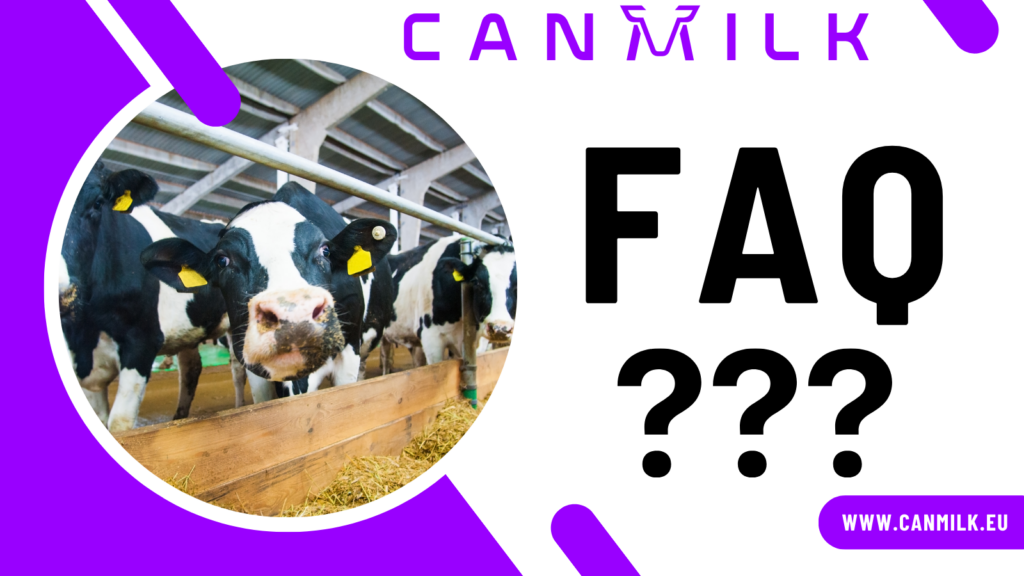
Find answers to your questions on the topics of methane mitigation and CANMILK.
Greenhouse Gases (GHG) are the gases responsible for what is called the “greenhouse effect”. Like the glass of a greenhouse, they keep the sun’s heat from leaving the atmosphere. This is generally a positive effect, as without it the Earth’s temperature would be on average -18 °C instead of the average 15°C we presently have. But as we emit more and more greenhouse gases, the greenhouse effect becomes stronger and the planet gets warmer and warmer – resulting in human-made climate change. Well-known greenhouse gases include carbon dioxide, nitrous oxide and methane.
(source)
Methane is the second largest contributor to global warming after carbon dioxide (CO2) and reflects about 100 times more heat than CO2. The lifetime of methane is only about 10 years, while CO2 can remain in the atmosphere for hundreds of years.
To standardise the climate impact of different greenhouse gases, we count them in “CO2 equivalents” (CO2e(q)). Because methane has a greater effect in trapping the heat, but a much shorter lifetime than CO2, it is considered to be 25-28 times as potent as CO2. This means that emitting of one ton of methane has the same effect as emitting of 28 tons of CO2.
(source)
Methane is a significant greenhouse gas, and one of its major sources is agriculture, particularly livestock farming. Cows, being ruminants, have a complex digestive system with a stomach consisting of four chambers. In the first chamber, the rumen, a process called “enteric fermentation” occurs. During this process, bacteria break down complex carbohydrates from the cow’s food into simple sugars and volatile fatty acids, which provide energy for the cow. A by-product of this digestion process is gas, primarily methane, which the cow expels through belching.
Although each cow produces a small amount of methane, the cumulative effect is substantial given the 77 million bovines in Europe. The methane concentration in a barn ranges from 20 to 200 ppm, which is about 0.002% to 0.02% of the barn’s air. This low concentration makes it impractical to combust the methane directly, highlighting the need for new technologies to address methane emissions in barns effectively.
(source)
Tackling greenhouse gas emissions is a priority of the European Green Deal. The EU’s methane strategy (COM2020/663), published in October 2020, sets Europe’s ambition and aims to curb temperature increases, improve air quality and reinforce the EU’s global leadership in the fight against climate change.
It focuses on reducing methane emissions in the energy, agriculture and waste sectors, which account for almost all human-related methane emissions. As announced in the EU methane strategy, the Commission adopted on 15 December 2021 a proposal for a regulation aimed at reducing methane emissions in the energy sector.
The new legislation will reduce methane emissions from the energy sector in Europe and in our global supply chains. It aims to prevent the avoidable release of methane into the atmosphere and minimise methane leakage from fossil fuel companies operating in the EU.
(source)
The ambitious goal of CANMILK is to develop a novel technology for methane conversion to CO2 which is a less harmful compound with 28 times lower global warming potential than methane. The project’s work focuses on methane activation by non-thermal plasma derived oxygen and hydrogen species enabling methane decomposition with the help of catalysts at mild conditions.
The CANMILK project aims to convert this technology to an innovative high-tech and low-cost solution to fight against ppm level methane emissions. Learn more about the CANMILK technology here: https://canmilk.eu/technologies/.
Plasma is the fourth state of matter, distinct from solids, liquids, and gases. It consists of charged particles: ions and electrons, making it very reactive and allowing the activation of gases, that are otherwise difficult to activate. In thermal plasma, the electron temperature is similar to the temperature of heavier particles (ions and neutrals). Examples of thermal plasma include stars and flames. Plasma is abundant in the universe, making up most of its visible matter. In everyday life, we encounter plasma in fluorescent lamps, neon signs, and lightning. (source)
Non-thermal plasma (NTP), also known as cold plasma or non-equilibrium plasma, is a state of matter that exists at temperatures much lower than those typically associated with plasmas. Non-thermal plasmas can be generated at temperatures close to or at room temperature, making them suitable for applications where high temperatures might be undesirable. In non-thermal plasmas, only a small fraction of gas particles become ionized, and the overall gas temperature remains relatively low. These plasmas have the unique ability to disrupt covalent bonds while the product is kept at ambient temperatures. (source)
Catalysts are substances that facilitate and accelerate chemical reactions without undergoing any permanent change themselves. They lower the activation energy required for a reaction to occur, making the reaction more favorable or efficient. Catalysts enable chemical transformations by providing an alternative reaction pathway, often speeding up the rate of the reaction. They play a crucial role in various industrial processes, including petrochemical production, pharmaceutical manufacturing, and environmental remediation. (source)
In CANMILK, new catalyst will be developed for the oxidation of activated methane and CHx radicals with the target conversion >90% to CO2. Project Partner Johnson Matthey is already among world leaders in this technology in particular in application to dilute methane feed-streams. The nature of dairy barn air requires specific evaluation for the application of catalysts, and development to tackle these specific challenges.
The expected impacts of the CANMILK project include:
1. Enhancing understanding of the feasibility and methods for mitigating non-CO2 greenhouse gases, with a focus on methane.
2. Assessing the techno-economic and environmental viability of plasma-based technologies for methane reduction.
3. Raising awareness about the impact of methane and other non-CO2 greenhouse gases on global warming.
You want to know more about the CANMILK project? Then you can contact us via e-mail: info@canmilk.com.